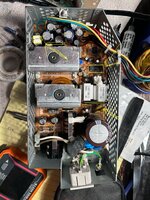I stayed up late recapping the PSU because I was on a roll. I tested it and got good voltage. But accidentally left it on overnight with no load. D'oh!
Now the voltages are low and all wrong. I pulled off and tested five of the new capacitors but found them to be still normal.
Replacing capacitors is really the only thing I know to do with my YouTube education. I'm hoping some pros can offer me guidance on what other components I should check and how to check them.
Thanks!
Now the voltages are low and all wrong. I pulled off and tested five of the new capacitors but found them to be still normal.
Replacing capacitors is really the only thing I know to do with my YouTube education. I'm hoping some pros can offer me guidance on what other components I should check and how to check them.
Thanks!

